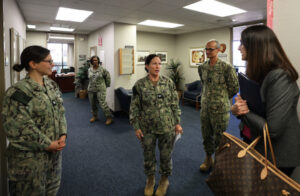
Story by Regena Kowitz
U.S. Navy Bureau of Medicine and Surgery
SAN DIEGO – Deputy Assistant Secretary of the Navy for Military Manpower and Personnel Ms. Lisa Truesdale visited Naval Medical Center San Diego, Feb. 14, to meet with staff who manage and support the Integrated Disability Evaluation System (IDES) process at the medical center.
Truesdale is responsible for establishment and oversight of policies related to health care, including IDES, within the Navy and Marine Corps.
During the first part of her visit, Truesdale met with IDES subject matter experts and both Rear Adm. Guido Valdes, Commander, Naval Medical Forces Pacific, and Director of the Defense Health Network Pacific Rim (DHNPR), and Capt. Elizabeth Adriano, director of Naval Medical Center San Diego (NMCSD) and commanding officer of Navy Medicine Readiness and Training Command San Diego.
Adriano, along with Cmdr. Nelly Rice, director for Warrior Transition, Lt. Col. Mitchell Guard, Wounded Warrior Battalion West (WWBn-W) commanding officer, and Capt. Michael Swanson, medical officer for WWBn-W, provided insight into the IDES process, while also addressing challenges and best practices.
Among the best practices are the “job fairs” hosted by Rice’s team. They provide service members on limited duty (LIMDU) and going through the IDES process an opportunity to match their skills with areas around the medical center that could use the extra hands.
According to Adriano, when service members come to NMCSD on LIMDU, they are “separated not only from their biological family, but also from their Navy family. They’re separated from their purpose, their job, their crew.”
While the main reason these service members are at the medical center is to get better and get back in the fight, by finding ways to keep them gainfully employed, the NMCSD team is giving them a purpose, which helps their morale and overall well-being, Adriano explained.
The command is also working to make the IDES process as efficient as possible by leveraging electronic systems to help move things along and standardize the process across the entire command, said Adriano.
“This is such a huge system with so much variance,” said Valdes. “We have done some good things and put in a lot of work, but there are so many steps in the process. To get our Sailors back to sea and our Marines back in the fight, we have to look at our process and understand where we can decrease the variances.”
Truesdale also visited the medical boards department where she thanked all the Physical Evaluation Board Liaison Officers (PEBLO) for their dedication and all they do to guide service members through the IDES process.
“I feel very privileged to have such a good team,” said Rice. “We have a lot of corporate knowledge here and they’re hard workers. I appreciate all they do.”
The next stop was to meet with staff at WWBn-W, which has a detachment at the medical center. Truesdale learned more about how the battalion supports their Marines through the IDES process and how being co-located at NMCSD puts medical expertise within easy reach. The battalion is structured around a recovery care team that includes recovery care coordinators, nurse managers, athletic trainers and coaches, and leadership who all come together in support of their Marines.
At the end of the visit, Truesdale asked what the team wanted her to know. “I’m going to host an IDES summit next week and it’s meant to purposefully figure out where we’re at, what we want to get after, what’s already going well, where we need to focus differently. We’re bringing a lot of people together to solve things.”
Before departing, Truesdale told the team, “You’ve given me a lot of things to think about when I fly home.”
Naval Medical Forces Pacific (NMFP) is Navy Medicine’s regional command in the Western Pacific. NMFP provides care to more than 675,000 beneficiaries comprised of active duty personnel, retirees, and their family members. The regional headquarters is located at Naval Base San Diego, with Navy Medicine Readiness and Training Commands (NMRTC) throughout the U.S. West Coast, Hawaii, Japan, and Guam.
Defense Health Network Pacific Rim (DHNPR) leads the Defense Health Agency’s (DHA) network of nine medical treatment facilities (MTF) on the West Coast and Pacific Rim. DHNPR is an integrated, adaptive, and capable network of hospitals and clinics, that deliver unparalleled health care to our active duty military, retirees, and their families.
The mission of Naval Medical Center San Diego (NMCSD)/Navy Medicine Readiness and Training Command San Diego (NMRTCSD) is to prepare service members to deploy in support of operational forces, deliver high quality health care services, and shape the future of military medicine through education, training, and research. NMCSD/NMRTCSD employs more than 5,000 active-duty military personnel, civilians and contractors in southern California to provide patients with world-class care anytime, anywhere.